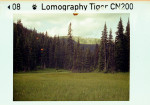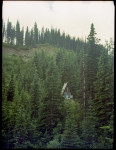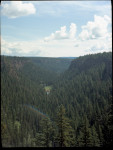Dec
23
2017

There are a lot of terrible plastic cameras that find their way into thrift store bins but sometimes there is the odd gem. The Minolta Autopak 70 falls more in the interesting pebble you turned over with your foot category. It has a 26mm f 3.5 4 element lens as well as a close up lens that slides in front. I didn’t have much success with that though as you can see bellow.

Despite its age it came with a working battery which is good because its uses a K battery which is pretty much unattainable. In the future I will need to build some type of replacement 4.5V but for now I have one.
With its electronic shutter the Autopak 70 has a speed range of 10 seconds to 1/330 second. If I had know this at the time I would definitely have tried a long exposure shot however doing that even with a tripod might be tricky as 110 cameras are mostly shaped like a rectangle with the shutter button on the far end for extra wobble when you press it. When done right though it produces and image that would be on par with a digital point and shoot camera from around the year 2000 but in a much more fun package.
no comments | posted in Cameras, Photography
Dec
16
2017

The Yashica MC is like a miniature version of an Electro 35 with nearly half the weight and twice the charm. It has the same type of infinitely variable electronic shutter that goes from 1/500 second to 4 seconds as the larger variants and its 40mm f2.8 lens while not as fast is still a decent performer.
The electronic shutter shouldn’t be confused with the modern idea of integrated circuits and processors its still a very analog system that essentially opens the shutter mechanically which also energizes the shutter circuit. An electromagnet holds the shutter open as long as current flows through one of the transistors but when the charge that is building up in a capacitor, controlled by the resistance of a CDS photo cell reaches a certain level another transistor turns on de-energizing the electromagnet and therefore closing the shutter and switching the circuit off again. This is why without batteries Yashica’s like this default to their maximum shutter speed, there is nothing holding the shutter open. There are other factors in the circuit as well such as the aperture which changes the resistance of another part of the circuit or the ISO setting. Okay when I started typing I thought it was going to be a simple explanation.
To sum it up: Wind film ,Press shutter, light on CDS and aperture determine shutter time, repeat.
My Electro 35 MC is stamped with ‘Hong Kong’ on the bottom so I can only presume that is where it was assembled but the 40mm F2.8 4 element lens is labeled as made in Japan
You can see a previous post about the Yashica MC Sept 2015 here
no comments | posted in Cameras, Photography, Uncategorized
Dec
10
2017
Sometimes you don’t get what you expect when you go out taking pictures. For a few years now I’ve been fascinated by the concept of Seattle’s Freeway park which has existed as a lid over the freeway since 1976. Through out most of my life my only interaction was passing beneath it when travelling through Seattle, completely oblivious to its existence. That all changed when I stumbled across it with Google maps. The idea of this hard edged concrete park intrigued me enough that I decided to make a trip to photograph it. I live several hours away in Canada so the easiest thing was to stay overnight in Seattle and then get up in the morning and photograph it. A wrinkle in my early morning low light idea was that while I packed my tripod I managed to neglect taking any of my tripod plates to actually mount a camera to it. As I write this I have only seen the digital photographs that I took the film remains undeveloped. The park itself is around 5 acres splayed along the line of the freeway and abutting a number of buildings. In this manner it seems less like a cohesive park and more like a number of similarly landscaped open courtyards. There is one area near the southern end of the park that is different and the main feature. This deep concrete canyon is the largest element and includes waterfalls. However as I was visiting in February if the water features are still operational they were likely turned off for the winter.

In the easily accessible public spaces the park was clean and well maintained but just as it serves as a lid over the freeway it also covers a separate living space for people on the edges of society. I’m not sure how many people call the nooks and crannies beneath the park home but once you are looking there seems to be evidence everywhere.
Continue reading
no comments | posted in Art observations, Photography
Dec
2
2017

This is the eighth post I have done with the Voigtlander Bessa 46 which is roughly one per year that I’ve been blogging. That seems about right as every so often I think to myself what camera haven’t I used in awhile that I want to use. I think that the reasons I enjoy using the Baby Bessa as much as I do is that it allows the use of medium format film with more of the feel of using a 35mm camera because of its small size.
I also like the option of doing multiple exposures as seen here.

The bad thing about the ability to do multiple exposures of course is that you need to be careful not to do them when you don’t want them.
A search through old magazines shows that in 1939 the Baby Bessa cost $49.59 which may not sound like much but considering that earning $1 an hour back then would have been pretty good pay makes it something not everyone would have considered purchasing.
no comments | posted in Cameras, Photography, Uncategorized
















































